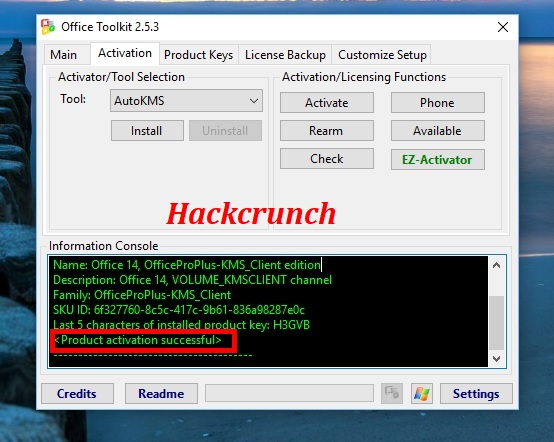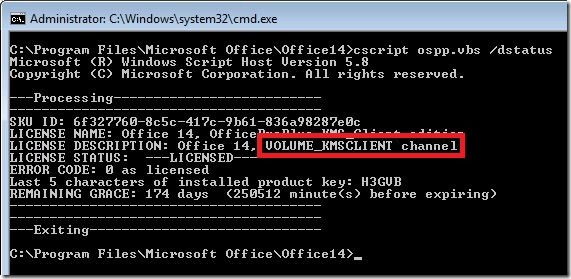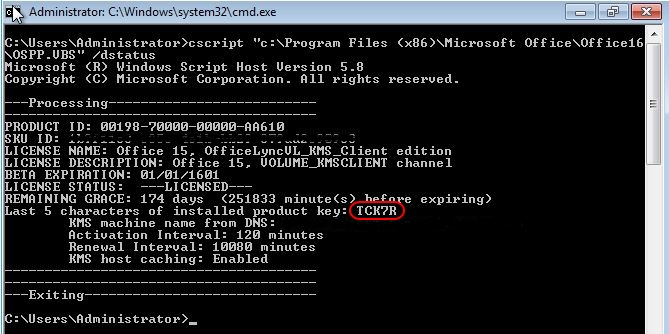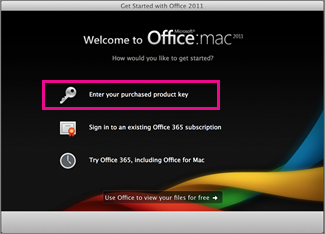-->
So, the KMS host thought it was the same client every time any of those machines hit the KMS host to attempt to activate Office 2010. Thus, the KMS host did not increment the counter. The moral to the story - when building the customized installation for deployment make sure no Office 2010 apps are launched before the image is captured. KMSPico is the ideal tool to activate the final version of Windows 7/8/8.1/10 and Office 2010/2013/2016. Activator does not require user intervention, the entire activation process takes place in the background, just run the activator and a couple of minutes to check the activation status of Windows and/or Office. Office 2019 KMS Activator Ultimate 1.4. Office 2019 KMS Activator Ultimate is the latest edition for Office Activation that helps you to activate the Office 2010, 2013, 2016, 365 and 2019 all versions in a more reliable way. You have the best chance to avail of this latest offer by Microsoft office. Processing- Installed product key detected - attempting to activate the following product: SKU ID: d450596f-894d-49e0-966a-fd39ed4c4c64 LICENSE NAME: Office 16, Office16ProPlusVLKMSClient edition LICENSE DESCRIPTION: Office 16, VOLUMEKMSCLIENT channel Last 5 characters of installed product key: WFG99 -Exiting- C: Program Files. Download KMS Activator for Windows & Office Searching for keys for Windows 10 and bypassing the mechanism for verifying its authenticity is a pressing problem for millions of users who have switched to a new operating system.
Kms Activator For Office 2016
This article was written by Eric Ellis, Senior Support Escalation Engineer.

When you troubleshoot KMS configuration and activation issues, you may find unexpected Windows or Office KMS hosts in their environment. This article describes how to discover Office and Windows KMS hosts through DNS, and how to remove unauthorized KMS hosts.
Note
The following steps are similar in Office KMS 2010, 2013, 2016, and 2019.
Discover Office and Windows KMS hosts through DNS
By default, Windows and Office clients discover KMS hosts through DNS and a related _vlmcs SRV record. To determine whether a KMS client can locate a KMS host or whether unwanted KMS hosts exist on the network, run a command similar to the following:
nslookup -type=srv _vlmcs._tcp >%temp%kms.txt

Review the kms.txt file, and it should contain one or more entries similar to the following:
Running this nslookup command frequently reveals _vlmcs SRV entries that are tied to unauthorized Windows or Office KMS hosts.
Remove unauthorized Windows KMS hosts
Kms Activator For Office 2016 Free
In many cases, Windows KMS hosts may be unintentionally set up by users who mistakenly entered a KMS host product key, instead of a Windows client product key. To resolve this issue, follow these steps on the computer(s) in question, replace the KMS product key and convert it to a KMS or MAK client:
Open an elevated command prompt.
Run
cscript slmgr.vbs /ipk xxxxx-xxxxx-xxxxx-xxxxx-xxxxx, where xxxxx-xxxxx-xxxxx-xxxxx-xxxxx is Windows product key (there should be 25 numbers).To prevent instability in the license service, restart the system or the Software Protection Service. To restart the Software Protection Service, run the following commands:
Run the following command to display the license information for the installed and active Windows edition:
cscript slmgr.vbs /dliIn DNS Manager, locate the appropriate forward lookup zone, and then delete the _vlmcs SRV records that exist for each computer which is not to serve as a Windows KMS host.
For more information, see the following articles:
Remove unauthorized Office KMS hosts
It's not common to create an Office KMS host unintentionally, because setting up an Office KMS requires a specific product key and the installation of the Microsoft Office 2010 KMS Host License Pack.
To determine whether a computer has the Office 2010 KMS Host License Pack installed and has an active Office KMS host, run the following command:
cscript slmgr.vbs /dlv bfe7a195-4f8f-4f0b-a622-cf13c7d16864
The output of a computer which has the Office 2010 KMS Host License Pack installed resembles the following. In the following example, key items are Partial Product Key: XXXXX and License Status: Licensed. These items indicate that the Office 2010 KMS host key is successfully installed and activated. To pull all the products installed, including all Office KMS host installations, run the following command:

cscript slmgr.vbs /dlv All >C:<path>KMSInfo.txt
Kms Activator For Office 2013

Kms Activator For Office 2011 Product
In this command, <path> equals where you want to write the output. In this file, search for Office and find all the instances for the Office KMS host installations. If you only want to pull specific Office KMS information, replace the Activation ID that is mentioned earlier in the command (bfe7a195-4f8f-4f0b-a622-cf13c7d16864) with the Activation ID for Office 2013, 2016, or 2019. An example of the output resembles the following:

Kms Activator Office 2011
Then, follow these steps to remove an Office KMS host in your environment:
Open an elevated command prompt.
Run the following command to uninstall Office KMS host product key:
cscript slmgr.vbs /upk bfe7a195-4f8f-4f0b-a622-cf13c7d16864Warning
If the command is run without the Office activation ID (bfe7a195-4f8f-4f0b-a622-cf13c7d16864), all installed product keys are uninstalled, including those for Windows.
Run the following command again to check the status of the Office KMS host:
cscript slmgr.vbs /dlv bfe7a195-4f8f-4f0b-a622-cf13c7d16864If the Office KMS host product key is removed, the output resembles the following. The key items are This license is not in use and License Status: Unlicensed.
In DNS Manager, locate the appropriate forward lookup zone, and then delete the _vlmcs SRV records that exist for each computer which is not to serve as an Office KMS host.
Kms Activator For Office 2010 Free Download
For more information, see the following articles: